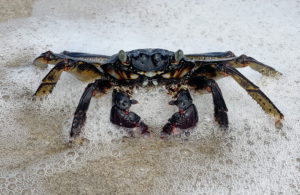
Hanalei rock crab, or ‘a‘ama, in sea foam. © Craig Thomas
February 18, 2021
I went to Kauai last weekend for a three-day family vacation. It was a treat to travel again, but costly Covid tests, soldiers checking papers at the arrival gate, and countless island shops and restaurants closed made this no regular interisland trip. Even so, traffic was light, residents friendly, and of course, the island is as breathtakingly beautiful as ever.
We watched white-tailed tropicbirds soar through Waimea Canyon, admired nene families grazing along the roadside, and strolled the length of Hanalei Beach singing “Puff the Magic Dragon.”
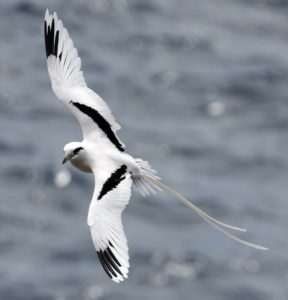
White-tailed Tropicbird. ©Photo courtesy Tom Fake
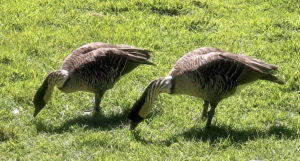
Nene, AKA Hawaiian Goose. ©Susan Scott
As we walked, an ‘a‘ama crab appeared in the sand near the shorebreak, and to our surprise, stayed put as we watched. The busy crab was eating something dead and yummy, and in its concentration, posed for pictures.
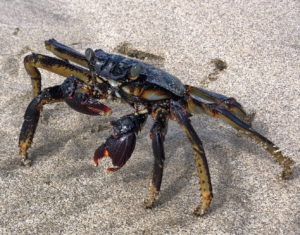
Hawaii hosts several species of rock crabs. This one, Grapsus tenuicrustatus, is black with a greenish tinge. In bright sunlight, such as in this picture, you can see tinges of red in the claws. ©Craig Thomas
Usually, ‘a‘ama are hard to see up close because upon a person’s approach, the crabs dash into cracks and crevices to hide. With good reason. For many local families, a‘ama are pupus.
My first introduction to ‘a’ama-eating occurred at a baby luau. Because I was new to Hawaii, and just beginning my marine biology studies, the sight of kids running around the party with black, spidery legs sticking out of their mouths shocked me. Our hostess showed me a plate of ‘a‘ama, explaining that the crabs are a delicacy. After removing the top shell, diners sprinkle sea salt on the exposed back, pop the whole crab in the mouth and suck the innards out, raw.
Also called rock crabs, ‘a‘ama are common in Hawaii, skittering like giant arachnids on rocks and breakwaters. Crabs are crustaceans, of course, but a visitor once told me she was surprised that Hawaii hosted so many tarantulas. In other parts of the world, people call red rock crabs Sally Lightfoots.
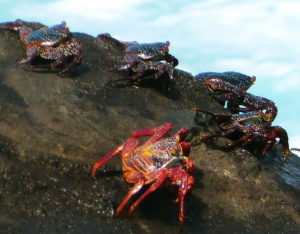
I found red Sally Lightfoot crabs mixed with black ones on the remote Mexican island of Isabela. In addition to color differences, the two species had slightly different shapes. ©Susan Scott
In the wild, we often see red-and-white shells of rock crabs. These aren’t dead crabs, but rather, are the molts of healthy, growing crabs. An ‘a‘ama’s molted shell is perfect in shape, but fragile without its structural minerals. It turns red from the heat of the sun.
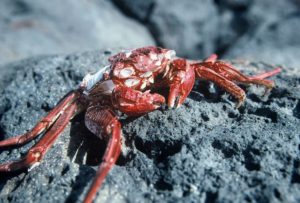
An aging ‘a’ama molt on Lanai. The exit slit is at the rear. This older molt crumbled when I picked it up. ©Susan Scott
When it’s time to grow, the crab expands its soft body parts with water and absorbs much of the calcium carbonate in its current shell. The puffed-up animal then backs out of a crack in the rear of the old shell. At this vulnerable time, the crab hides while its new, bigger shell hardens. This “soft-shell” stage of swimming crabs known as Chesapeake blue crabs is an East Coast delicacy.
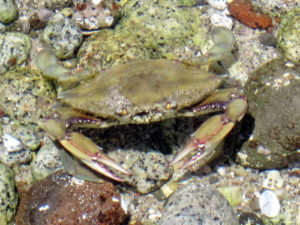
Swimming crabs have a pair of paddlelike legs at the rear, enabling them to swim. This one turned to threaten me in an Australian tide pool. ©Susan Scott
We weren’t able to summon dragons during our Kauai visit, but the Garden Isle treated us to its own living magic: Soaring seabirds, grazing geese, and one camera-loving ‘a‘ama.
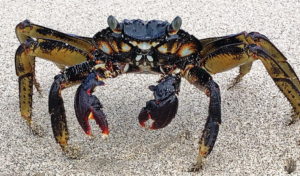
Hawaii’s a‘ama shells grow to about three inches wide, and are native to shorelines throughout the Indian and Pacific Oceans. ©Craig Thomas